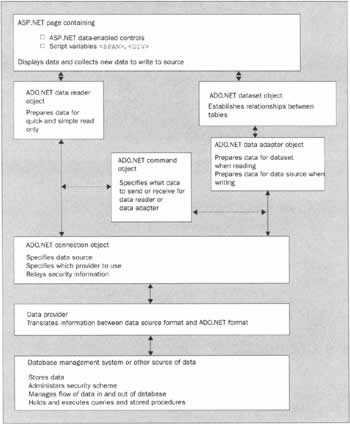What is a Connection?
|
An ADO.NET connection provides a conduit for communication between the data consumer (say, the ASP.NET code that you write, executed on IIS) and the source from which you need to retrieve data. This conduit, though, does more than just relay information - it can also perform translation of the data as it moves from the store to the ASP.NET page.
In a superficial way, we can think of the connection as a layer between the data and the page that's eventually displayed on the user's screen. More specifically, it is the layer between the provider that interacts directly with the data source, and the ADO.NET objects that use the data (for example, the DataSet object). These objects (with help from command objects, DataTables, and others) then pass information to ASP.NET controls for display. Like so much else in the .NET Framework, an ADO.NET connection is presented to the programmer as an object. In fact, there are a number of different connection objects; which one you find yourself using will depend upon the data source you're dealing with. Once you've created a connection object, however, the range of operations that you can perform with it is for the most part independent of the data source. The following diagram shows where the connection object fits in the layers of communication that exist between a data source and an ASP.NET page: As this discussion develops, it's important to keep in mind two things that a connection object doesn't do. First, a connection object doesn't specify what data (what fields and what records) to get from a specified source - as we'll see later, this is done by a command object, working in conjunction with a data reader or data adapter object. Second, the connection object doesn't directly cause the data store to perform reading or writing on the data. The connection simply starts a data session that's supported by ADO.NET at the data consumer end, and by the database engine (or some other data source) at the data provider end.
Differences between ADO and ADO.NET ConnectionsIf you've had any dealings with 'classic' versions of ADO (ADO 2.0, ADO 2.1, and so on), you may be wondering about the differences between ADO.NET and ADO. With regard to connection objects, there are five basic changes:
If you haven't dealt with ADO before, don't worry: in ADO.NET, many of the complexities alluded to above have been ironed out. In the pages to come, we'll be covering all that you need to know in order to use ADO.NET with confidence.
Database Connections Available in ADO.NETAs mentioned briefly above, one of the most important advances from classic ADO to ADO.NET is the creation of .NET data providers. When you install the .NET Framework, two such providers come along with it: the OLE DB .NET data provider, and the SQL Server .NET data provider. A third - the ODBC .NET data provider - may be downloaded from Microsoft (http://www.microsoft.com/downloads; search for 'ODBC .NET data provider'). It's likely that other specialized .NET data providers will become available in the future, not necessarily from Microsoft. The SQL Server .NET data provider is highly optimized for connections to just one type of data source: Microsoft SQL Server 7, or higher. It isn't even able to talk to other SQL-language RDBMSs (such as Oracle, or IBM's DB2). The SQL Server .NET data provider connects to the RDBMS at the level of the Tabular Data Stream (TDS), and thus completely avoids the OLE DB layer. If you're using Microsoft SQL Server, as we'll spend most of our time doing in this book, then the SQL Server data provider is by far your best choice.
For almost all other data sources, we can use the OLE DB .NET data provider. This works with any OLE DB-compliant data source, including SQL Server, but in that particular case it's slower than the SQL Server .NET data provider we just mentioned. The OLE DB .NET data provider's versatility is such that it can be used with non-relational data such as Excel spreadsheets, right up to enterprise-strength relational systems such as Oracle and IBM's DB2. Our third alternative here - the ODBC .NET data provider - has two uses. First, we can employ it to connect to data at the ODBC level - this is 'lower down' than OLE DB, and thus slightly faster. Second, there are some old data stores for which only an ODBC service is available, such as Borland's Paradox. Unless your situation requires ODBC, however, it's better to work with the supplied OLE DB .NET data provider.
| |||||||||||||||||||||||||||||||||||
EAN: 2147483647
Pages: 263

